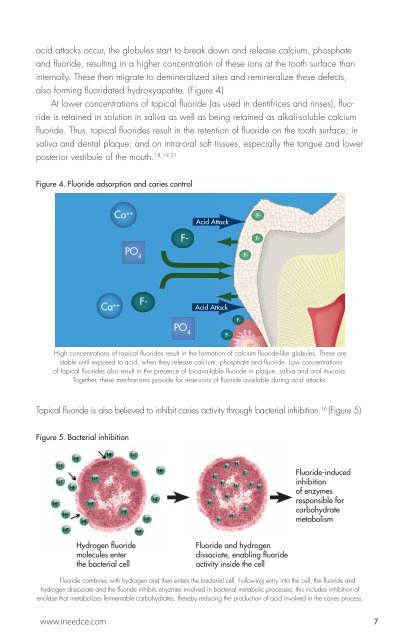Create successful ePaper yourself
Turn your PDF publications into a flip-book with our unique Google optimized e-Paper software.
acid attacks occur, the globules start to break down and release calcium, phosphate<br />
and fluoride, resulting in a higher concentration of these ions at the tooth surface than<br />
internally. These then migrate to demineralized sites and remineralize these defects,<br />
also forming fluoridated hydroxyapatite. (Figure 4)<br />
At lower concentrations of topical fluoride (as used in dentifrices and rinses), fluoride<br />
is retained in solution in saliva as well as being retained as alkali-soluble calcium<br />
fluoride. Thus, topical fluorides result in the retention of fluoride on the tooth surface; in<br />
saliva and dental plaque; and on intra-oral soft tissues, especially the tongue and lower<br />
posterior vestibule of the mouth. 18,19,21<br />
Figure 4. <strong>Fluoride</strong> adsorption and caries control<br />
Ca ++<br />
F-<br />
Acid Attack<br />
F-<br />
F-<br />
F-<br />
Ca ++ PO 4<br />
PO 4<br />
F-<br />
Acid Attack<br />
F-<br />
F-<br />
High concentrations of topical fluorides result in the formation of calcium fluoride-like globules. These are<br />
stable until exposed to acid, when they release calcium, phosphate and fluoride. Low concentrations<br />
of topical fluorides also result in the presence of bioavailable fluoride in plaque, saliva and oral mucosa.<br />
Together, these mechanisms provide for reservoirs of fluoride available during acid attacks.<br />
Topical fluoride is also believed to inhibit caries activity through bacterial inhibition. 16 (Figure 5)<br />
Figure 5. Bacterial inhibition<br />
<strong>Fluoride</strong>-induced<br />
inhibition<br />
of enzymes<br />
responsible for<br />
carbohydrate<br />
metabolism<br />
Hydrogen fluoride<br />
molecules enter<br />
the bacterial cell<br />
<strong>Fluoride</strong> and hydrogen<br />
dissociate, enabling fluoride<br />
activity inside the cell<br />
<strong>Fluoride</strong> <strong>com</strong>bines with hydrogen and then enters the bacterial cell. Following entry into the cell, the fluoride and<br />
hydrogen dissociate and the fluoride inhibits enyzmes involved in bacterial metabolic processes; this includes inhibition of<br />
enolase that metabolizes fermentable carbohydrates, thereby reducing the production of acid involved in the caries process.<br />
www.ineedce.<strong>com</strong> 7

















